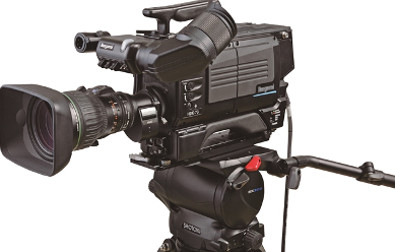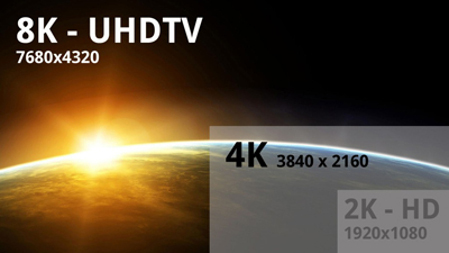Is It Time to Think About 8K?
For the past several years, the video industry has been promoting 4K and the inclusion of “HDR” (high dynamic range) to boost the dynamics of color. Now, as the industry migrates to the higher resolution format, 8K is beginning to emerge, making some wonder if 4K is simply a short term “bridge” to 8K.

Ikegami HDK 73
Companies including Ikegami, Hitachi and RED have been showing 8K cameras at industry trade shows worldwide for the past half-decade. You can even get an 8K test generator from For-A (ESG-8000) and other companies are quickly gearing up for 8K including Nippon Control Systems, NEC, JVC and Canon, among others.
At this year’s NAB Show, Ikegami will launch its new 2/3-Inch 8K Portable Camera and display their sample SHLM-5510W 55-inch 8K monitor and Hitachi will showcase its SK-UHD8000 camera. Sony is also involved in the development of 8K as a member of NexTV-F, a technology advancement initiative backed by the Japanese government, of which Japanese broadcaster NHK and others like the BBC’s Research and Development department with the Olympic Broadcasting Services (OBS) have played a major role. Ross Video has been working with 12G so their Ultrix router can actually handle 8K when it’s treated as a “quad-link 12G,” and the Ross Acuity switcher can currently switch 8K when using “bus follows” (meaning the “strapping” of multiple inputs together to use as one). Ross President David Ross says the company’s 12G DA’s can be used for quad-link 12G to handle the full bandwidth of a 48G 8K image uncompressed.
On the consumer side, 8K consumer displays from LG, Samsung and Hisense have been shown on the CES exhibit floor for the past two years and in terms of cameras, Canon produces DSLR’s up to 50 Megapixels, which can produce better than 8K images, (though currently the camera only offers 4K recording).
THE CURRENT STATE OF 8K
Before understanding 8K’s development we need to understand the current status of 4K. Cameras are available today and manufacturers are still pushing different delivery methods from IP to coaxial 12G. Switchers are handling 4K by using four HD channels (quad-link 3G) to provide the bandwidth needed to handle 12G. And about every other piece of equipment needed to record or produce is out there or showing at this year’s NAB Show. Interest in 4K is increasing outside of the broadcast arena, according to Sean Moran, chief operating officer for Hitachi Kokusai Electric America Inc. “4K requests are up from houses of worship and the sporting and staging markets,” he said. “We have current interest from professional sports leagues on the 8k but they are just exploring at this time.”
The professional video industry's #1 source for news, trends and product and tech information. Sign up below.
According to Ross “we have lots of products that can do 8K as badly as everyone else, and in several cases much better. Why badly? Because most work today is done with 16 link 3G. We have a full suite of 3G products. The better solution is quad link 12G. Since Ross is a leader in 12G we have a better story for 8K than most.”

In terms of resolution, 8K is 16 times sharper than 1080p HD. Although there is no marketing term for 8K in the United States, (like UHD for 4K), in Japan, the NHK has adopted the “Super Hi-Vision” (SHV) moniker for the high-resolution format. Unlike the difference between 4K and UHD—where there is a slight variation in resolution with 4K being something closer to a 17.1x9 image (4096x2160) and UHD being a 16x9 “broadcast” image (3840x2160)—currently 8K SHV maintains the standard 16:9 aspect ratio, with 7680x4320 resolution in approximately 33 Megapixels.
In addition to this massive resolution, SHV features a 22.2 multichannel sound system consisting of three vertical layers of speakers. The reasoning behind this is that 22.2 channels can provide the growth path to the future of surround, as well as providing the audio in multiple simultaneous languages which, according to LifeWire technical writer Robert Silva, could make a universal world-wide broadcast possible. The NHK, which has taken the lead in development testing, has already been shooting events in the U.S., including Major League Baseball games and the Super Bowl. Last summer, NHK covered the Rio Games in Brazil using two 8K mobile units utilizing Ikegami’s fourth-generation SHK-810 cameras, according to Alan Keil, vice president and director of engineering for Ikegami. In three years, according to NHK, the network plans to broadcast the 2020 Olympics from Tokyo in full 8K to live audiences worldwide.
“NHK had been targeting 2020 for the commercial start of 8K,” said Keil. “More recently they pulled it forward a couple of years, I suspect in an effort to persuade the market that they should wait for 8K instead of an interim 4K. I think at this point they may have conceded that this strategy has not really worked. So maybe we are back to 2020.”
BANDWIDTH CONSTRAINTS
Like 4K, the main concern over 8K includes bandwidth. Due to the high bit rate and great bandwidth requirements, it seems like initial compression of signals might be necessary. This is because the data rate of 8K stands at 48 Gbps as uncompressed, but something about half that rate should be achievable under a yet-to-be-determined compression format. If 8K is compressed, this is still about twice the data of 4K (uncompressed at a full 12G). Uncompressed 8K is of course significantly greater in bandwidth; this a lot of data to be moving and storing. One way manufacturers are handling this massive bandwidth of 8K is with 16 coax cables, each carrying 3G. And like 4K using four 3G cables, 8K can use four 12G coax cables. This is early in the 8K development so the actual cabling is far from finalized with any particular cabling solution (whether IP, uncompressed, compressed, coax, or some unknown new carrier).
As video technology develops and migrates from HD to 4K and eventually 8K, it might be assumed that the higher resolution will exceed the needs of the typical home viewer; there comes the point where higher resolution is not apparent (or less apparent) until the actual image displayed is far above the existing average screen size of about 65 inches (for a consumer TV). 8K will make the greatest impact at large venue displays from digital theaters to stadiums—public exhibition displays where the screen could easily exceed 50 feet or even 100 feet.
The concern on the production end with 8K (as it’s becoming apparent with 4K), is the amount of space needed to store so much data. In the typical “TV style” production environment, iso-recording five cameras in 8K in addition to the program (“clean and dirty”) constitutes a massive amount of data and storage. For HD it was challenging, and 4K it was difficult; but in “film style” production with a single camera or even just a two-camera production, 8K is more manageable. The size and cost of storage must be considered when it comes to production and 8K video acquisition costs are directly associated with the amount of space required to store, which also requires careful management of assets.
8K as a broadcast TV format is very unlikely in the near future as bandwidth is getting more precious and the spectrum continues to shrink. Although ATSC 3.0 accommodates 4K, it will still take several years for the standard to deploy; meanwhile cable and satellite providers also recognize the vast amount of bandwidth space and data needed. Even utilizing a strictly IP-based system requires not only large bandwidth, but extremely reliable throughput for live viewing (although for 8K playback of previously recorded material, you have the luxury of reduced bandwidth while your material is downloaded). Despite these concerns, the Japanese continue to forge ahead with the necessary production and consumer gear for 8K with the goal of an 8K 2020 Tokyo Olympics, so, perhaps now is the time to think about 8K.
Dan Slentz is the chief video engineer for New World Center in Miami Beach, Fla. He can be reached via TV Technology.
